
| Video Technology Magazine | February 2006 |
UPDATE: I have a site that will be related to this topic AdvancedGui.com since some the the research VT has done in the past relates to this.
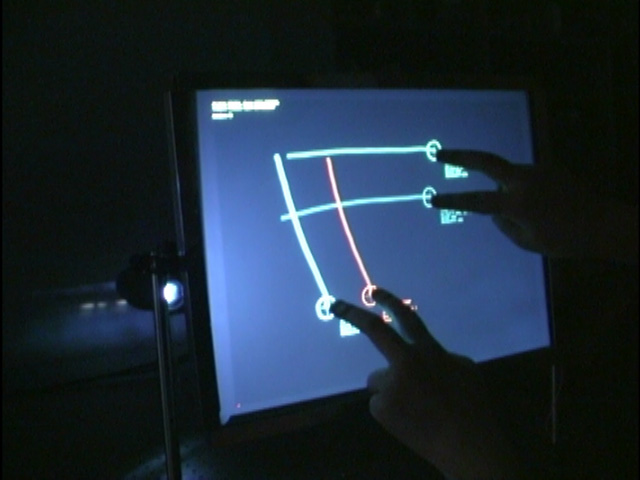
They call the technology FTIR (frustrated total internal reflection) a technique well known in the biometrics community for fingerprint image acquisition. The system uses a rear-projection display with a video camera on the back-side of the surface to detect where fingers touch the display. 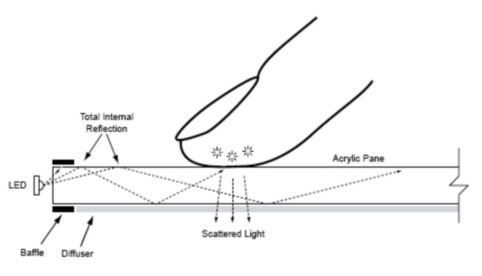
There is an amazing demo video of this on YouTube.com (mentioned earlier)
Apple has patented some these interactions such as the pinch movement for zooming, shown in this video.
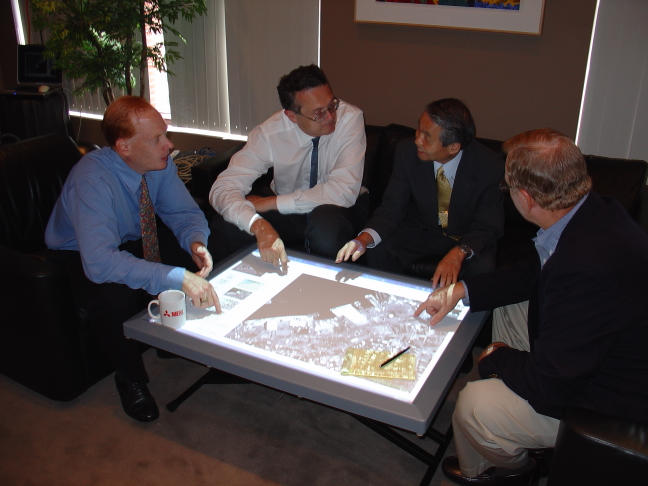
Video of DiamondTouch in action (QuickTime) , Clip is also on YouTube
From Slashdot:
Internet Growth Is Slowing, So We Instinctively Seek New Ways of Growing and New Rules to Make It Happen "For the transition of television to the Net, then, heavily data center-based ventures are unlikely to be successful in the long-term. Google and its distributed shipping containers might be right for this moment or next, but they can do the math and that math tells them that pumping tens of millions of simultaneous HDTV unicasts from a Google server is no way to make money. It is much better to use Google servers to seed video content, which is then shared by many peers. This is pretty much the only way the system can scale high enough to functionally replace and then improve on today's TV."
ZDNet has an article talking about worries over the increase in video downloads in the last year. Free video hosting and the popularity of iTunes is blamed for this phenomenon." From the article: "This is far from an academic issue. Whether the new companies can deliver on their promises could have a profound effect on how the Internet operates--and it could hit consumers in the pocketbook. Business and entertainment content worth billions of dollars now flows over ordinary ISP networks. Internet voice calls, which can be garbled by any network congestion, are increasingly common. Serious online hiccups could be as irritating, and potentially economically damaging, as persistent L.A. traffic jams."
Implementation of HDCP requires a license obtainable from the Digital Content Protection, LLC , which then issues a set of unique secret device keys to all authorized devices. According to the Microsoft specification, high-definition video content that is transported using a DVI signal must be encrypted with HDCP. If HDCP is not present, regardless of whether an attempt at copying is made or not, the video is scaled down to low resolution to deter copying. For a manufacturer that wishes to use HDCP technology on its products, a signup with Digital CP is required. Upon a signed agreement, the manufacturer must pay the committee an annual fee of $15,000 and a royalty fee of $0.005 per product sold. This allows a manufacturer to provide DVI/HDCP support, sufficient for high-resolution output. If a manufacturer wants to implement HDMI, a DVI-compatible connector, an additional $15,000 annual fee to HDMI is needed along with $0.04 per product. To actually implement HDCP protection, unique keys are required on a per product basis which is provided by the committee and requires implementation at the manufacturing level.
Many of ATI's recent retail products are currently shipping with advertisements claiming that the products are HDCP-ready. On ATI's website, the term HDCP-ready was also used, for example on the X1900 series specifications page. Curiously, ATI's professional products such as FireGL list "HDCP-compliant".
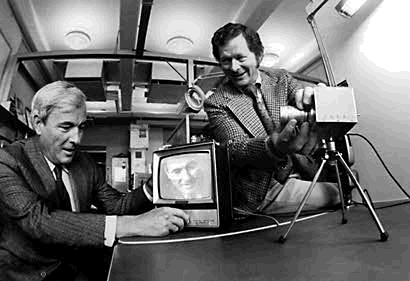
Willard Boyle (left) and George Smith (right) demonstrating a TV camera that uses a CCD. Photo courtesy of Lucent Technologies Bell Labs Boyle and George Smith will share the $500,000 US award for the invention of the "Charge-Coupled Device (CCD), a light-sensitive component at the heart of digital cameras and other widely used imaging technologies," the U.S. National Academy of Engineering said." Those other devices include the Hubble Space Telescope, and orthoscopic medical instruments. "Boyle and Smith came up with the idea for the device while working at Bell Laboratories in 1969. 'It was after maybe an hour's work,' Boyle recalled. 'We went over to the blackboard and we had some sketching there. We went down to our models lab and made one.'
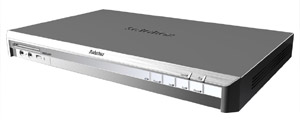 SetaBox make an wmv9/H.264 IP STB targeted at Triple play.
It supports many Streaming Protocol RTP/RTSP, HTTP, MMS, IGMP v.2.0, ISMA, PS / TS.
The STB is based on the Philips Nexperia video DSP.
SetaBox make an wmv9/H.264 IP STB targeted at Triple play.
It supports many Streaming Protocol RTP/RTSP, HTTP, MMS, IGMP v.2.0, ISMA, PS / TS.
The STB is based on the Philips Nexperia video DSP.
Photo of CES 2006 Booth (High Res)

Photo of SetaBox STB internals (High Res)
From: XXXXX@cmp.com Sent: Wednesday, February 01, 2006 11:39 AM To: XXXXX@videotechnology.com Subject: Re: DV Expo Hi John, You're correct. We're not doing DV Expo East this year. While the show has been enthusiastically received by exhitors and attendees, we haven't been able to make it make business sense. Instead, we are focusing our resources on DV Expo West in November, and we are exploring other event-related opportunities, the nature of which is TBA. Cheers, Dom Dominic M. Editorial Director | CMP Media's Digital Video Group
DV Expo West is now just DV Expo and is still on.
For More info goto 2006 Video Tradeshows Calandar
|

Jason Lee Miller 2006-02-20 A poll conducted by Harris Interactive shows that most consumers would be willing to give up their cable or satellite TV subscriptions if an acceptable IPTV alternative were offered. Also, while a switch to IPTV may prove challenging for networks and cable companies, it offers a better TV experience for the consumer.
Though few said they would cancel their cable and satellite services
immediately without a trial run or waiting to see how early adopters
liked it, 93 percent said they'd have one or the other, but not both.
Just over half (56%) of US adults say they have heard of IPTV and
substantial numbers indicated an interest in giving it a try.
The interactive features that garnered the most interest include:
· The ability to save money, since IPTV should be far less costly than cable or satellite (42%)
Twelve percent of adults say they would sign up and try IPTV immediately if it were only available for their PC, and 57 percent say they would wait and see how others like it. Almost one in five (18%) say they would try IPTV immediately if it were available for their PC and could be sent to TV's in their house using a set-top box, and 59 percent said they would wait and see how others like it.
"It's no surprise to find that consumers want to save money on
their cable or satellite bill, but the survey results also show that
many consumers are quite interested in having access to a broad range
of content to watch, at a time they determine," said Milt Ellis, vice
president and senior consultant for the Technology Research Practice at
Harris Interactive.
I don't know but is seems like customers are dying for this. Funeral One make video editor specifically for making memorial videos. Funeral Video Creation Software.
After the notorious JPEG patent which has made many big and small names pay huge amounts to Forgent (total more than $105 million), PCMag reports that AT&T claims to have a patent covering core MPEG-4 technology and has warned Apple and others of Patent Infringement. Pentax and Nero have already paid them.
Think Secret is reporting that the true video iPod is slated for announcement soon. It will have a 3.5 inch display and will eschew the mechanical click wheel in favour of a touch screen version. The 5th generation iPod released prior to the holiday season last year is described as a souped up 4G iPod with video capabilities. This new iPod will be the 'true' video iPod. It looks like there is not going to be wireless support. The article hints that the release date could be April 1 which is the 30th anniversary of Apple.
This image processor is not your typical digital camera. It took 6 years, 20 people, and $6 million to build the 'Regional Calorimeter Trigger' (RCT) which will be a component of the Compact Muon Solenoid (CMS) experiment, one of the detectors on the Large Hadron Collider (LHC) in Geneva, Switzerland. The RCT will fill several racks of space in order to process 4 trillion bits of information per second while analyzing a billion proton collisions per second. The camera is currently being tested at the University of Wisconsin at Madison before being shipped to Geneva in June to participate in the first experiments in 2007.
Red Herring has a story on the forthcoming price of Sony Blu-Ray HD DVDs. At $23.45 wholesale, they aren't cheap. From the article: 'Some of the movies to be released in the first batch by Sony are The Fifth Element, Desperado, Hitch, House of Flying Daggers, Legends of the Fall, and Terminator. Sony's wholesale price of $23.45 for Blu-ray discs is 56 percent more than the $14.99 it costs to buy a new DVD of Hitch from BestBuy.com. A Terminator DVD is available for $9.99.' Another reader suggested a link to an Ars Technica article with more information.
Wired is reporting that several companies are developing electronically controlled lenses to provide enhanced vision. From the article: Thanks to technologies created for astronomical telescopes and spy satellites, aberrometers can map a person's eye with extreme accuracy. Lasers bounce off the back of the eyeball, and structures in the eye scatter the resulting beam of light.
The number of telephone wiretaps from 2000 to 2004 authorized by state and federal judges increased by 44%, the Wall Street Journal reports, in part because of a rise in terrorism investigations after 9/11, and because the Patriot Act extended surveillance to Internet providers. All the surveillance activity can put a strain on carriers. 'Smaller telecom companies in particular have sought help from outsiders in order to comply with the court-ordered subpoenas, touching off a scramble among third parties to meet the demand for assistance', the WSJ reports, adding, 'Government surveillance has intensified even more heavily overseas, particularly in Europe. Some countries, such as Italy, as well as government and law-enforcement agencies, are able to remotely monitor communications traffic without having to go through the individual service providers. To make it easier for authorities to monitor traffic, some also require registering with identification before buying telephone calling cards or using cybercafes.'
SyncCast CRN, DRM
From Erich Strasser OLEDs are the latest and most promising buzzwords in display technology. To give you an idea of their potential, imagine a cardboard-thin TV screen. Now imagine that you can roll up your TV, put it away or carry it wherever you go. Automatically, you start appreciating why millions, if not billions, of dollars are being poured into OLED research every year. Short for organic light-emitting diode, a display device that sandwiches carbon-based films between two charged electrodes, one a metallic cathode and one a transparent anode, usually being glass. The organic films consist of a hole-injection layer, a hole-transport layer, an emissive layer and an electron-transport layer. When voltage is applied to the OLED cell, the injected positive and negative charges recombine in the emissive layer and create electro luminescent light. Unlike LCDs, which require backlighting, OLED displays are emissive devices - they emit light rather than modulate transmitted or reflected light. More Information about OLED technology at: http://www.oled-display.net http://www.oled.at This is an interesting add I ran across: 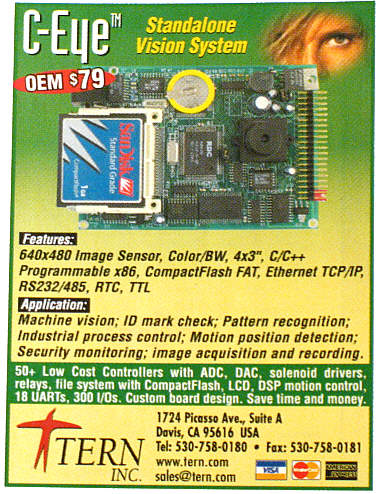
C-Eye Smart Camera * Compact 3" x 4" (75mm x 100mm) * CMOS Image Sensor (640x480, 320x240), 20 fps nominal rate * Supports grayscale, 256-color, 24-bit color * Wide viewing angle Micro Lens * 16-bit CPU (186), x86 compatible * 9-30VDC input, very low power < 1W * CompactFlash memory with FAT filesystem. * 10-baseT Ethernet w/ TCP/IP * RS232/RS485, RTC, Battery * Numerous digital I/Os
|
|||||||||||||||||||||||||||||||||||||
Copyright © 2005, John L. Sokol
|
|
 Video screens have shown up all over in recent years -- cell phones, bathrooms, car head rests, subway cars, even elevators. Next up: a solar-powered video panel embedded in a tombstone that plays a clip reminiscent of "This Is Your Life.''
Video screens have shown up all over in recent years -- cell phones, bathrooms, car head rests, subway cars, even elevators. Next up: a solar-powered video panel embedded in a tombstone that plays a clip reminiscent of "This Is Your Life.''